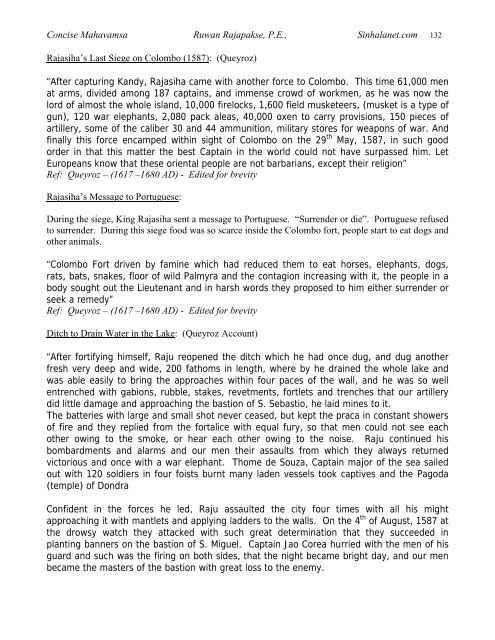Concise Mahavamsa Ruwan Rajapakse, P.E., Sinhalanet.com 1
Concise Mahavamsa Ruwan Rajapakse, P.E., Sinhalanet.com 1
Concise Mahavamsa Ruwan Rajapakse, P.E., Sinhalanet.com 1
You also want an ePaper? Increase the reach of your titles
YUMPU automatically turns print PDFs into web optimized ePapers that Google loves.
<strong>Concise</strong> <strong>Mahavamsa</strong> <strong>Ruwan</strong> <strong>Rajapakse</strong>, P.E., <strong>Sinhalanet</strong>.<strong>com</strong> 132<br />
Rajasiha’s Last Siege on Colombo (1587): (Queyroz)<br />
“After capturing Kandy, Rajasiha came with another force to Colombo. This time 61,000 men<br />
at arms, divided among 187 captains, and immense crowd of workmen, as he was now the<br />
lord of almost the whole island, 10,000 firelocks, 1,600 field musketeers, (musket is a type of<br />
gun), 120 war elephants, 2,080 pack aleas, 40,000 oxen to carry provisions, 150 pieces of<br />
artillery, some of the caliber 30 and 44 ammunition, military stores for weapons of war. And<br />
finally this force encamped within sight of Colombo on the 29 th May, 1587, in such good<br />
order in that this matter the best Captain in the world could not have surpassed him. Let<br />
Europeans know that these oriental people are not barbarians, except their religion”<br />
Ref: Queyroz – (1617 –1680 AD) - Edited for brevity<br />
Rajasiha’s Message to Portuguese:<br />
During the siege, King Rajasiha sent a message to Portuguese. “Surrender or die”. Portuguese refused<br />
to surrender. During this siege food was so scarce inside the Colombo fort, people start to eat dogs and<br />
other animals.<br />
“Colombo Fort driven by famine which had reduced them to eat horses, elephants, dogs,<br />
rats, bats, snakes, floor of wild Palmyra and the contagion increasing with it, the people in a<br />
body sought out the Lieutenant and in harsh words they proposed to him either surrender or<br />
seek a remedy”<br />
Ref: Queyroz – (1617 –1680 AD) - Edited for brevity<br />
Ditch to Drain Water in the Lake: (Queyroz Account)<br />
“After fortifying himself, Raju reopened the ditch which he had once dug, and dug another<br />
fresh very deep and wide, 200 fathoms in length, where by he drained the whole lake and<br />
was able easily to bring the approaches within four paces of the wall, and he was so well<br />
entrenched with gabions, rubble, stakes, revetments, fortlets and trenches that our artillery<br />
did little damage and approaching the bastion of S. Sebastio, he laid mines to it.<br />
The batteries with large and small shot never ceased, but kept the praca in constant showers<br />
of fire and they replied from the fortalice with equal fury, so that men could not see each<br />
other owing to the smoke, or hear each other owing to the noise. Raju continued his<br />
bombardments and alarms and our men their assaults from which they always returned<br />
victorious and once with a war elephant. Thome de Souza, Captain major of the sea sailed<br />
out with 120 soldiers in four foists burnt many laden vessels took captives and the Pagoda<br />
(temple) of Dondra<br />
Confident in the forces he led, Raju assaulted the city four times with all his might<br />
approaching it with mantlets and applying ladders to the walls. On the 4 th of August, 1587 at<br />
the drowsy watch they attacked with such great determination that they succeeded in<br />
planting banners on the bastion of S. Miguel. Captain Jao Corea hurried with the men of his<br />
guard and such was the firing on both sides, that the night became bright day, and our men<br />
became the masters of the bastion with great loss to the enemy.


